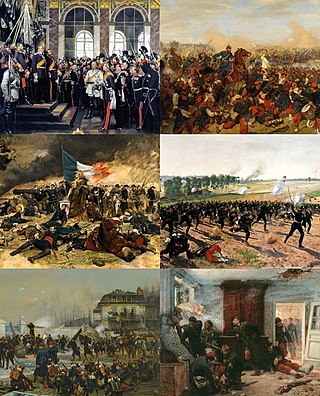
The Franco-Prussian War or Franco-German War, often referred to in France as the War of 1870, was a conflict between the Second French Empire and the North German Confederation led by the Kingdom of Prussia. Lasting from 19 July 1870 to 28 January 1871, the conflict was caused primarily by France's determination to reassert its dominant position in continental Europe, which appeared in question following the decisive Prussian victory over Austria in 1866. According to some historians, Prussian chancellor Otto von Bismarck deliberately provoked the French into declaring war on Prussia in order to induce four independent southern German states—Baden, Württemberg, Bavaria and Hesse-Darmstadt—to join the North German Confederation; other historians contend that Bismarck exploited the circumstances as they unfolded. All agree that Bismarck recognized the potential for new German alliances, given the situation as a whole.
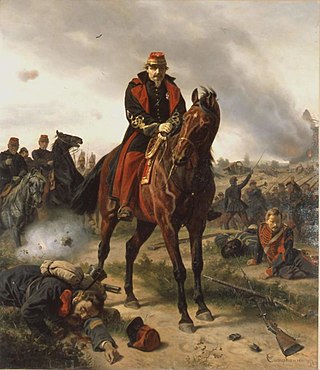
The Battle of Sedan was fought during the Franco-Prussian War from 1 to 2 September 1870. Resulting in the capture of Emperor Napoleon III and over a hundred thousand troops, it effectively decided the war in favour of Prussia and its allies, though fighting continued under a new French government.

The siege of Metz was a battle fought during the Franco-Prussian War from August 19 to October 27, 1870 and ended in a decisive allied German victory.

The siege of Paris took place from 19 September 1870 to 28 January 1871 and ended in the capture of the city by forces of the various states of the North German Confederation, led by the Kingdom of Prussia. The siege was the culmination of the Franco-Prussian War, which saw the Second French Empire attempt to reassert its dominance over continental Europe by declaring war on the North German Confederation. The Prussian-dominated North German Confederation had recently emerged victorious in the Austro-Prussian War of 1866, which led to the questioning of France's status as the dominant power of continental Europe. With a declaration of war by the French parliament on 16 July 1870, Imperial France soon faced a series of defeats at German hands over the following months, leading to the Battle of Sedan, which, on 2 September 1870, saw a decisive defeat of French forces and the capture of the French emperor, Napoleon III.
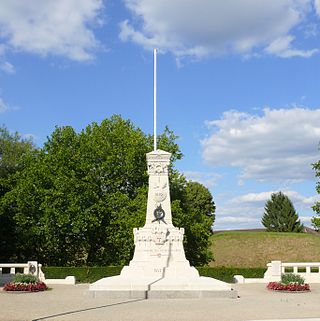
The siege of Toul was the siege of the fortified French town of Toul from 16 August to 23 September 1870 by Prussian, Bavarian and Württemberg forces during the Franco-Prussian War. Toul controlled a railway line leading to Germany and it was vital for the Germans to secure it to resupply and reinforce their armies in northern France.
The Battle of Châtillon, also known as the Battle of Châtillon-sous-Bagneux, was a skirmish in the Siege of Paris between France and North German Confederation in the Franco-Prussian War, took place on 13 October 1870. This is also considered the first battle in the history of the French Third Republic. In this fierce battle – occurred at Châtillon and Sceaux, Corps V of the Prussian army under the command of Lieutenant General Infantry Hugo von Kirchbach, along with the II Corps of the Kingdom of Bavaria by the Supreme Minister infantry Jakob von Hartmann which were the forces of the army Group 3 of Prussia by Prince Friedrich Wilhelm as General command., won a victory against an attack by the XIV Corps under General Renault - of the French army under General Auguste-Alexandre Ducrot. Although some soldiers under Ducrot fought well, the majority of his army became agitated. The French were forced to flee to Paris, losing the Châtillon Plateau - a very favorable defensive position overlooking the fortresses south of Paris - to the Germans. This was a disaster for the "justice" of the French army during the war, although the French reported that they suffered only minor losses.

Wilhelm René de l'Homme de Courbière was a Prussian field marshal who served in several wars of the 18th century and during the Napoleonic Wars. Stemming from a French Huguenot family; he notably held the fortress of Graudenz against Napoleon's troops throughout 1807, long past the Peace of Tilsit, until the siege was finally lifted after 11 months.
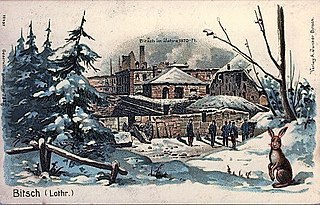
The siege of Bitche was a battle during the Franco-Prussian War initially caused by the German forces on August 8, 1870 to March 26, 1871, where the two nations would sign a armistice. The siege was considered a brave siege under the command of governor Louis-Casimir Teyssier, and of the chief of the troops of the place: Geniès-Hippolyte Bousquet who both would be appointed lieutenant-colonels during the siege.
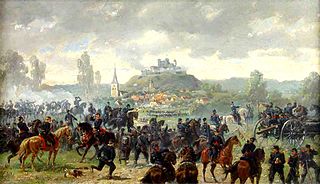
The siege of Lichtenberg was a battle of the Franco-Prussian War that took place on August 9–10, 1870 at Lichtenberg Castle between French and German troops. After a brief but fierce shelling a German force under the command of Generalmajor Hermann Freiherr von Hügel, part of the Württemberg Division and the Third Army forced the surrender of the French garrison of Lichtenberg under the command of Second Lieutenant Archer. In addition to Lichtenberg, in a single period in August 1870, the German army also defeated the French fortresses of La Petite-Pierre, Marsal and Vitry-le-François.
The siege of Marsal was a battle of the Franco-Prussian War on August 13 to 14 between the French Empire and the combined German forces of Prussia and Bavaria in Marsal. Under the command of Lieutenant General Jakob von Hartmann, after replacing the Prussian 4th Cavalry Division, II Corps of the Kingdom of Bavaria forced the surrender of the French Empire's defenses, after a brief resistance by the French troops stationed at the fortress. Marsal fell to the German army in the same period as the French fortresses of Lichtenberg, La Petite-Pierre and Vitry. With the quick victory of the Bavarian army at Marsal, the road from Dieuze to Nancy was open to the Germans. In addition, the siege also brought the Germans a lot of raw materials for the war, as well as hundreds of prisoners.

The siege of Montmédy was a battle of the Franco-Prussian War at the small commune of Montmédy, in the Meuse, it was besieged by the army of the German coalition. Defended by the 57th Line Infantry Regiment, the Garde Mobile and elements of other units, it surrendered on December 14, 1870.
The siege of Verdun was a battle fought in France during the Franco-Prussian War from 13 October until 8 November 1870.
The siege of Neu-Breisach was a battle of encirclement in the Franco-Prussian War, which took place from 13 October until 10 November 1870 in France. A few days after the surrender at Fort Mortier of Neu-Breisach, with a divisional reserve, German General Hermann von Schmeling forced the fortress of Neu-Breisach which surrendered, and won many spoils from the French army here. The siege demonstrated the high efficiency of the Baden batteries. With the surrender of Neu-Breisach, the Imperial German Army captured the last of the fortifications at Alsace, except for the Belfort and of Bitche. After this victory, Von Schmeling moved his cannons southwest to carry out the Siege of Belfort.
The Siege of La Fère took place during the Franco-Prussian War from 15 November until 26 November 1870, at the fortress of La Fère in France. French troops stationed at La Fère under the command of Captain Jacques Ferdinand Planche resisted the siege from the Imperial German Army, but surrendered the fort after eleven days on 26 November 1870, which resulted in a German victory. During the siege, the German army captured thousands of prisoners, most of whom were Garde Mobile soldiers, and took control of many French weapons. The German shelling of La Fère took place over the course of two days and severely damaged the town. After the Germans captured La Fère, they used cannons to arm the stronghold of Amiens.
The siege of Sélestat was a siege, extending from 20 to 24 October 1870, of the French Alsatian fortress of Sélestat, during the Franco-Prussian War. After artillery bombardment by the Germans, the siege ended when the French army surrendered, mainly because the French garrison was demoralized. The Germans suffered only minor losses, while this victory brought them many spoils.
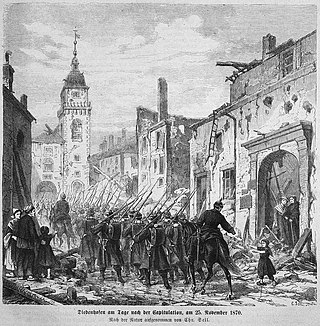
The siege of Thionville was a battle of the Franco-Prussian War which occurred in Thionville of the Moselle from November 13 to November 24, 1870. The small French garrison repulsed an attempted attack on August 14. It was subjected to a blockade and then besieged from November 13. After the capitulation of Metz, on October 28, 1870, the Prussians move part of their powerful artillery to Thionville. Bombed from November 22, the square surrendered on November 24. The capture of Thionville and that of Montmédy a month later gave the Germans control of the railroad to the Picardy front.
The siege of Mézières was a siege battle during the Franco-Prussian War, it took place from November 17, 1870 until January 2, 1871, in Mézières-en-Gâtinais which is located on the banks right of the river Meuse in France. After suffering from a German artillery strike, the French army at Mézières under the command of Colonel Vernet, surrendered to Germany under the command of Major General Wilhelm von Woyna on January 2, 1871. Although lasting just over a day, German artillery bombardment caused French defenders and civilians in Mézières heavy losses. With the victory, the Germans captured many French officers and soldiers, with many cannons and supplies from the enemy's reserves. Not only that, the victory at the Siege of Mézières made the German army have complete dominance of the railway line in the north extending from Metz and Mézières to Paris, capital of France.

The siege of Peronne was a battle during the Franco-Prussian War, from December 26, 1870 until January 9, 1871, in Péronne, Somme of France. The German siege force, under the command of Lieutenant Generals August von Goeben and Albert von Barnekow, forced the French army at Péronne- which could not be rescued and had to surrender after more than a week under the bombardment of the Prussian army. With the victory, the armies of Albert von Barnekow captured a defending force of thousands of French soldiers in Peronne, and obtained a large number of cannons and war materials to the Prussians hands. In general, the advantage of the artillery of the Prussians as well as the dynamism of German officers is credited with leading to German victories in the sieges of French fortresses, and the success at the Siege of Péronne solidified German control over the river Somme.

The siege of Rocroi was a battle of the Franco-Prussian War, it was held in January 4 to the 6th, 1871 at Rocroi which was a bastion of France located to the west of Sedan. After an artillery fire by the Prussian army, the officer commanding the French troops at Rocroi was forced to surrender the Division Militia under General Schuler and Sendan and Wilhelm von Woyna. With the success of the Siege of Rocroi, the military spectrum was obtained on their hands were hundreds of prisoners along with many stocks, costumes and contemporary heavyweight artillery of the French. During this siege, the town of Rocroi was heavily destroyed. The fall of Rocroi marked one of the German army's consecutive victories in the war.
The siege of Longwy was a military conflict during the Franco-Prussian War, which took place from January 16 to the 25th, 1871, in the Longwy which was near the border of Belgium and Luxembourg. After the artillery fire from the Prussian army, the siege ended with the defenders of Longwy under the command of Colonel Massaroly surrendering to Prussia under the command of Colonel Von Cosel. With this victory, the Prussian army captured many prisoners and cannons of the enemy. This was one of the consecutive victories of the German army in a short period of time during the war. The town of Longwy was badly damaged during the siege.












